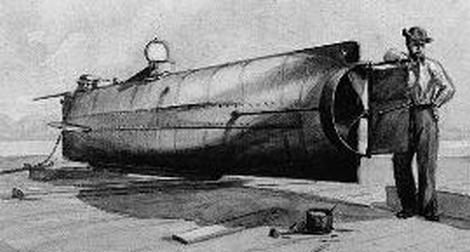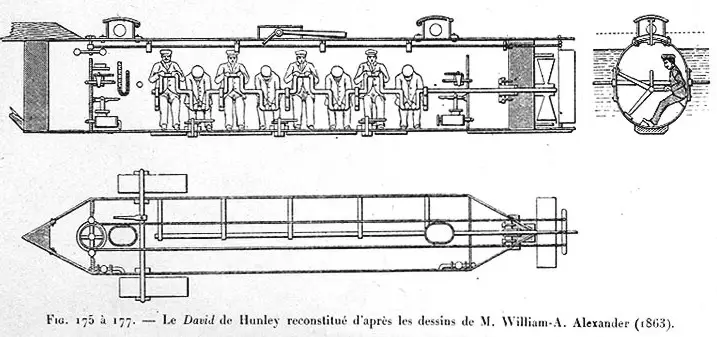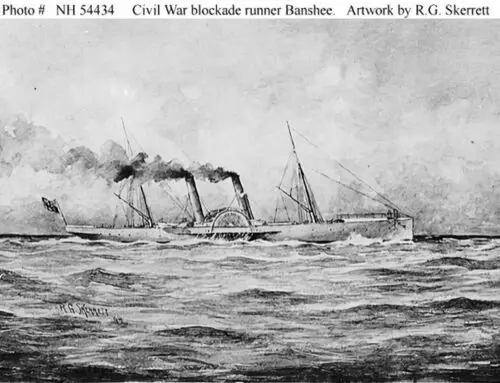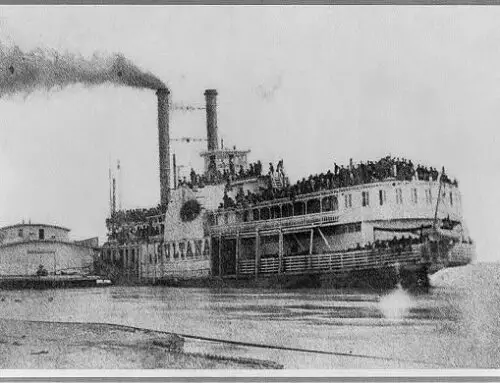The H.L. Hunley is famous for being the first submarine to sink an enemy ship. Preceding the Hunley was the first American submarine used during the Revolutionary War called the Turtle (also called the American Turtle), which was an incredibly small and crude version of an underwater boat.
The Turtle was not the first submarine, or inspiration for a submarine, ever constructed, but it laid the foundation upon which the concept of submerged ships are used as a tool against other vessels. The Turtle was lost during the onset of the American Revolutionary War after failing to blow up a British ship, HMS Eagle in New York Harbor in 1775.

H.L. Hunley submarine sitting on a pier
The H. L. Hunley was a landmark vessel used during the American Civil War and was the first submarine that effectively sank an enemy ship. The events surrounding the Hunley are tragic, enigmatic, and intriguing, leaving historians, archaeologists, academics, and students of history searching for answers and knowledge about this strange and fascinating piece of American military history.
The Hunley is often called different names. Sometimes it is just called the Hunley. It is also called the C.S.S. Hunley (Confederate States Ship) or H.L. Hunley (named after its inventor Horace Lawson Hunley) or its sometimes called the C.S.S. H.L. Hunley. I will refer to it in this article as the H.L. Hunley.
What Was the H.L. Hunley?
The H. L. Hunley was a Confederate submarine, constructed in 1863 from a cylindrical wrought iron steam boiler plate, tapered at the bow (front) and stern (back) of the ship with customized fittings to make it both unique and useful for its purpose. The submarine measured approximately 40 feet (12 meters) in length and had a displacement of around 7.5 short tons.
The boat was commissioned during the American Civil War (1861-1865) and was the third Confederate iteration of preliminary submarines built in the 19th century. The first two Confederate submarines were the C.S.S Pioneer and the C.S.S. American Diver; the Union had a comparable ship in production as of 1861, the U.S.S. Alligator, which was set adrift by its transport ship in 1863 near Cape Hatteras when it encountered rough waters and bad weather.
The Pioneer, similarly, was abandoned after the Union captured New Orleans in 1862, and the American Diver was left at the bottom of the bay of Fort Morgan when it sank during a test run in 1863 near Mobile, Alabama.
Who Created the H.L. Hunley?
The H.L. Hunley, also built in Mobile, was designed by Tennessean born lawyer and maritime engineer Horace Lawson (H.L.) Hunley, who, while living in New Orleans, was inspired by a call to action against the Union’s naval blockade of Confederate ports.
Having financed the production of the Pioneer and American Diver alongside with James McClintlock and Baxter Watson, Mr. Hunley was well versed in the production of submarines. After the loss of the American Diver, Mr. Hunley moved quickly to build a brand-new ship and continue his work.
Mr. Hunley’s new undersea boat sank on August 29th, 1863, during its first test when the commanding officer, Lieutenant John A. Payne, accidentally opened a hatch and killed 5 of the 8-man crew. The Confederate military took over the tests, recovering the ship and resetting it for a new round of assessments, which Mr. Hunley took over at the last minute.
He, and the entire crew, perished during the second experiment on October 15th, 1863, when it failed to resurface from its submersion. Once the submarine was subsequently recovered, it was named after Mr. Hunley in his honor. The refurbished C.S.S H. L. Hunley was put to task under its new commanding officer, Lieutenant George E. Dixon to take out part of the Union blockade of Confederate ports.
It had been brought to Charleston via the railroad and then deposited into the harbor on the fateful day of February 17th, 1864. It would be the submarine’s one and only mission.
How Was the H.L. Hunley Powered?
The H.L. Hunley was powered by hand crank which required a team to operate. Seven men, seated on a long bench, would grasp the long crank, and turn it together to power the vessel through the ocean. The boat was first dropped off into the port by a ship after being transported by train to the seaside. The crew inside of the ship would turn the crank to move it forward as it was steered by the captain at the front of the ship.

Illustration of the inside of the H.L. Hunley
What Makes the H.L. Hunley Unique?
The H.L. Hunley is the first submarine in history to successfully sink an enemy ship. While there had been previous attempts to use underwater ships to attack enemy vessels, none had ever been effective. This lay the foundation for future missions involving submarines, an evolution of submarines, and innovation in the global navies. This can be reflected in what we see in over one and half centuries of naval warfare.
What Ship Did the H.L. Hunley Sink?
The Hunley was assigned to break through the blockade of Charleston Harbor by Union ships on February 17th, 1864. With a crew of one officer, Lieutenant Dixon, and 7 volunteers of the Confederate military and the Confederate states, the C.S.S. H. L. Hunley was sent out to complete its task.
After successfully deploying the spar torpedo (a rudimentary bomb that was attached to the front of the ship by a long metal pole and rope) into the hull of the USS Housatonic, the Hunley’s torpedo successfully blew a hole into the Union sloop-of-war. The Housatonic sank within a few minutes at the cost of 5 Union lives and several injured. The survivors were quickly picked up by the remainder of the blockade.
What Caused the Hunley to Sink?
Following its mission, the H.L. Hunley disappeared after the explosion and never returned to port. Speculation as to its whereabouts and/or destruction were fueled throughout the South for well over a century due to the legend of the ship itself, and it was not until the late 20th century (according to some), early 21st century that the H.L. Hunley was rediscovered.
There are several theories surrounding the cause of the sinking of the Hunley, although the most common and widely accepted theory was the Hunley was too close to the U.S.S. Housatonic when the torpedo detonated, probably about 20 feet (6 meters) within range of the vessel, causing the ship to also be lost. The Hunley was not physically affected by the blast of its target, ruling out that it had blown open or damaged from the explosion.
The crew were found to have died at their posts and did not display obvious wounds. Because there did not seem to be an attempt to escape by any member of the crew, this has led archaeologists to believe the might of the blast had sent powerful shockwaves through the ship which either incapacitated the crew, which caused them to drown, or immediately killed them with pulmonary hemorrhages (burst blood vessels in their lungs).
What Was Found Inside the H.L. Hunley?
The bodies of the eight-man crew were recovered and were eventually all identified:
- Lieutenant George E. Dixon (Ohio or Alabama; he was the only known person on the ship prior to recovery)
- Corporal Johan Frederik Carlsen (suspected Denmark origin)
- James A. Wicks (North Carolina/Florida)
- Augustus Miller (suspected German origin)
- Lumpkin (suspected British origin)
- Frank Collins (Virginia)
- Joseph F. Ridgeway (Maryland)
- Arnold Becker (suspected German origin).
When the Hunley was salvaged, the Hunley revealed a trove of artifacts from the mid-19th century. These items included:
- A silver alloy and antler pocketknife (found on Dixon)
- 8 canteens (found on crew members)
- A metal rudder (found on ship)
- 16 pairs of shoes (found on crew)
- A lantern with a clear/white glass face (found on ship)
- A couple of naval buttons (found on Becker)
- A pair of binoculars (found on Dixon)
- A burnt matchstick (found on ship)
- A wick (found on ship)
- A warped and inscribed 1860 minted gold $20 coin (found on Dixon)
- Wooden bench (found on ship)
- A diamond ring (found on Dixon)
- A wooden and metal hammer (found on ship)
- Silver suspenders (found on Dixon)
- A silk bandana (found on Wicks)
- An oil can (found on ship)
- A diamond brooch (found on Dixon)
- A Union identification tag bearing the name Ezra Chamberlin (found on Ridgeway)
- A gold watch (found on Dixon)
Some of the items are obvious in their nature, whether they were built into the ship or part of the function of the vessel, such as the hammer, oil can, rudder, or bench, or part of the crew’s uniform or equipment, such as the buttons, shoes, or bandana.
Of all the objects found on the ship, however, a few have inspired imagination and curiosities surrounding the histories of the enigmatic crew, such as the Union identification tag, which may have been a souvenir collected from a previous battle or the accidental deposit left over from a Union spy’s snooping of the ship, although all of this is the result of conjecture.
The gold coin found on Dixon’s hip is the most well known and most speculated item from the Hunley. It had been in Dixon’s pocket when he was injured at the Battle of Shiloh, distorted by the impact of a bullet, and leaving traces of lead on it. Dixon is said to have credited carrying the coin as a life saver and good luck charm.
Whether the coin had been a gift to him by his sweetheart prior to the war or something he had with him at the time of the battle is unknown, although many believe the coin to be a romantic keepsake gifted to Dixon when he left for the war in 1861. On the one side of the coin was the face of Lady Liberty while on the other was an eagle with a sanded-out portion which had an engraving etched into it. The inscription read:
“Shiloh
April 6th, 1862
My life Preserver.
- E. D.”
Where is the H.L. Hunley now?
The Hunley currently resides at the Warren Lasch Conservation Center at the Charleston Navy Yard, North Charleston, South Carolina. Archaeologists, historians, and scientists have been working tirelessly to preserve and study the Hunley, its crew, and the artifacts recovered from the ship.
The crew’s remains were buried with full military honors in Magnolia Cemetery in Charleston, South Carolina in 2004, near the grave of H.L. Hunley who had been buried there in 1863 after the fateful test of his submarine.


